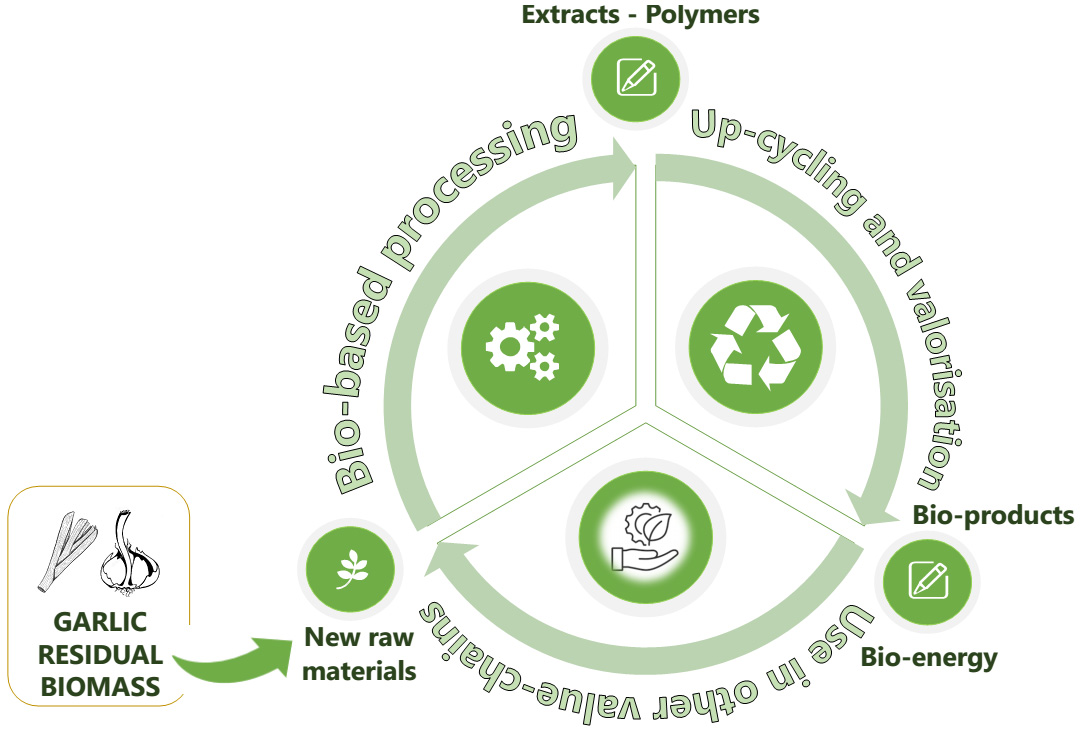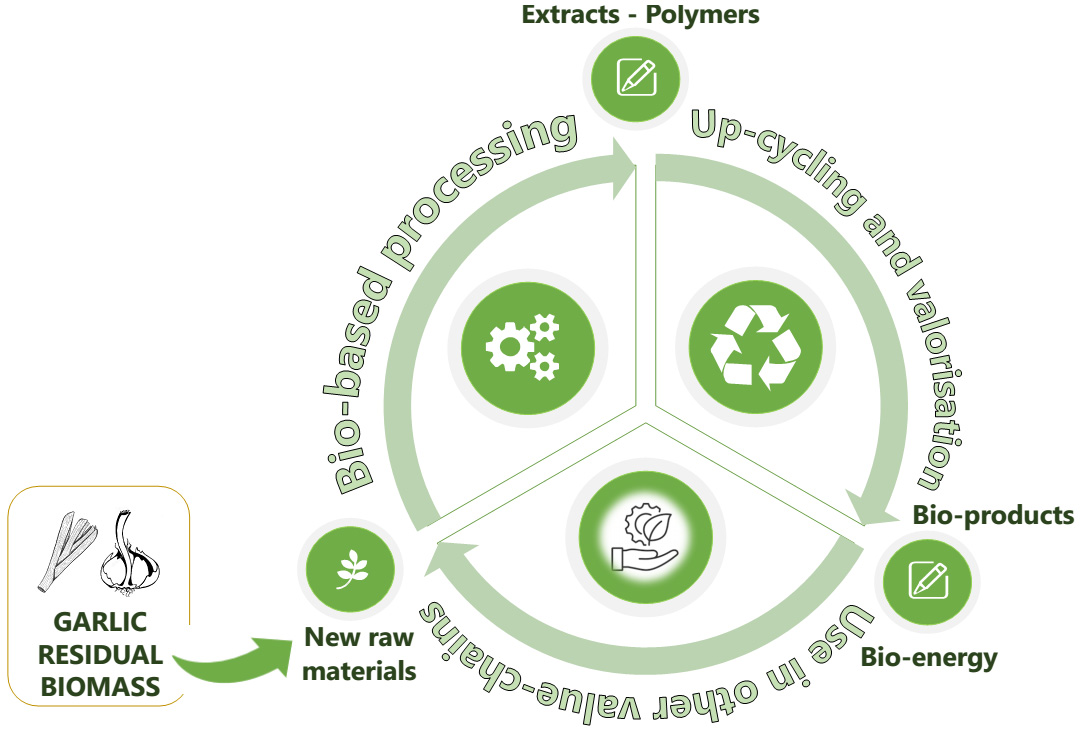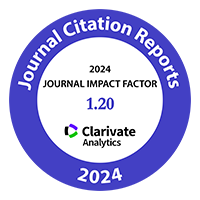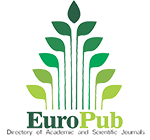Overview of garlic waste management, circular economy and upcycling
DOI:
https://doi.org/10.48162/rev.39.165Palabras clave:
compuestos bioactivos, biopolímeros, economía circular, residuos del ajo, compuestos organosulfurados, pectina, valorizaciónResumen

In the last three years, 2 billion tonnes of untreated and dismissed agricultural wastes have been accumulated without adequate management of reuse or final disposal, resulting in dumping or burning. The circular economy concept has gained increasing global recognition for addressing environmental and economic challenges. Garlic, the second most common bulb vegetable cultivated worldwide, generates significant waste during its industrial processing, including husks, stalks, straws, and leaves. These wastes, representing 3.0 to 3.7 million tonnes of residual biomass per year, are currently underutilised, with the usual treatment involving dumping in landfills or direct burning, leading to increased soil and air pollution. In this review, we aim to encourage innovation by presenting a search for state-of-the-art garlic waste management. We identified studies about garlic residual biomass valorisation as raw material for obtaining different extracts and polymers, even energy or biofuels. Finally, following circular economy principles, we propose potential uses for garlic by-products to be repurposed or upcycled as materials within agricultural or other production chains. The information above reveals an increasing demand and interest in garlic waste valorisation. Future studies are needed to exploit garlic by-products as important sources of biopolymers and phytochemicals.
Highlights:
- Garlic Waste Generation: Garlic production generates 3.0 to 3.7 million tonnes of residual biomass annually, including husks, stalks, and leaves.
- Current Disposal Methods: Garlic by-products are often disposed of through landfilling or burning, causing environmental pollution and resource loss.
- Valorisation Potential: Garlic residual biomass can be valorised into bioactive compounds, biopolymers, biofuels, and other sustainable materials.
- Circular Economy Approach: By-products from garlic can be integrated into circular economy models for use in agricultural and industrial production.
- Future Research Directions: Further research is needed to optimize garlic by-products for biopolymer and phytochemical production, enhancing sustainability.
Descargas
Citas
Agustin, M.; Ahmmad, B.; Richel Enna, P. de L.; Buenaobra, J.; Salazar, J.; Hirose, F. 2013. Starch-based biocomposite films reinforced with cellulose nanocrystals from garlic stalks. Polymer Composites. 13: 1325-1332. https://doi.org/10.1002/pc.22546
Ai-Lian Lim, B.; Lim, S.; Ling Pang, Y.; Hoong Shuit, S.; Huei Wong, K.; Boon Ooi, J. 2022. Investigation on the potential of various biomass waste for the synthesis of carbon material for energy storage application. Sustain. 14: 2919-2936. https://doi.org/10.3390/su14052919
Ali, M.; Ibrahim, I. S. 2019. Phytochemical screening and proximate analysis of garlic (Allium Sativum). Archives of Organic and Inorganic Chemical Sciences. 4: 478-482. https://doi.org/10.32474/AOICS.2019.04.000180
Amarakoon, S.; Jayasekara, D. 2017. A review on garlic (Allium sativum L.) as a functional food. Journal of Pharmacognosy and Phytochemistry. 6: 1777-1780.
Araújo de Souza, M.; Tavares Vilas-Boas, I.; Maria Leite-da-Silva, J.; do Nascimento Abrahão, P.; Teixeira-Costa, B. E.; Veiga-Junior, V. F. 2022. Polysaccharides in agro-industrial biomass residues. Polysaccharides. 3: 95-120. https://doi.org/10.3390/polysaccharides3010005
Arruda, E. H.; Melatto, R. A. P. B.; Levy, W.; Conti, D. de M. 2021. Circular economy: A brief literature review (2015–2020). Sustainable Operations and Computers. 2: 79-86. https://doi. org/10.1016/j.susoc.2021.05.001
Asfaram, A.; Fathi, M. R.; Khodadoust, S.; Naraki, M. 2014. Removal of Direct Red 12B by garlic peel as a cheap adsorbent: Kinetics, thermodynamic and equilibrium isotherms study of removal. Spectrochimica Acta - Part A: Molecular and Biomolecular Spectroscopy. 127: 415-421. https://doi.org/10.1016/j.saa.2014.02.092
Azmat, F.; Imran, A.; Islam, F.; Afzaal, M.; Zahoor, T.; Akram, R.; Aggarwal, S.; Rehman, M.; Naaz, S.; Ashraf, S.; Hussain, G.; Suleria, H.; Ali, Q.; Bibi, M.; Batool, F.; Gul, F.; Amjad, N.; Asif Shah, M. 2023. Valorization of the phytochemical profile, nutritional composition, and therapeutic potentials of garlic peel: a concurrent review. International Journal of Food Properties. 26: 2642-2655. https://doi.org/10.1080/10942912.2023.2251713
Barber, T. M.; Kabisch, S.; Pfei, A. F. H.; Weickert, M. O. 2020. The health benefits of dietary fibre. Nutrients. 12: 1-17. https://doi.org/10.3390/nu12103209
Belkheiri, A.; Forouhar, A.; Ursu, A. V.; Dubessay, P.; Pierre, G.; Delattre, C.; Djelveh, G.; Abdelkafi, S.; Hamdami, N.; Michaud, P. 2021. Extraction, Characterization, and applications of pectins from plant by-products. Applied Sciences Journal. 11: 1-25.
Burba, J. L.; Lanzavechia, S.; Lopez, A. 2021. Enfoque de la producción de ajo para una economía circular (INTA). http://hdl.handle.net/20.500.12123/10215
Caglar, A.; Aydinli, B. 2018. The pyrolysis of industrial alliaceous plant wastes. Energy Exploration and Exploitation. 36: 1672-1707. https://doi.org/10.1177/0144598718759559
Chaurasia, H.; Chandel, S. R. 2021. A Review: Impact of garlic on human health. International Journal of Biology, Pharmacy and Allied Sciences. 10: 935-947. https://doi.org/10.31032/ ijbpas/2021/10.3.5404
Chhouk, K.; Uemori, C.; Wahyudiono; Kanda, H.; Goto, M. 2017. Extraction of phenolic compounds and antioxidant activity from garlic husk using carbon dioxide expanded ethanol. Chemical Engineering and Processing: Process Intensification. 117: 113-119. https://doi. org/10.1016/j.cep.2017.03.023
Chitsaz, H.; Oraji, H.; Keramat Amirkolaei, A.; Akrami, R. 2018. Effect of garlic peel on haematological, biochemical and digestive enzyme activity in beluga juvenile (Huso huso). Iranian Journal of Aquatic Animal Health. 4: 13-28. https://doi.org/10.29252/ijaah.4.1.13
Coman, V.; Teleky, B. E.; Mitrea, L.; Martău, G. A.; Szabo, K.; Călinoiu, L. F.; Vodnar, D. C. 2020. Bioactive potential of fruit and vegetable wastes. Advances in Food and Nutrition Research. 91: 157-225. https://doi.org/10.1016/bs.afnr.2019.07.001
Cooney, R.; de Sousa, D. B.; Fernández-Ríos, A.; Mellett, S.; Rowan, N.; Morse, A. P.; Hayes, M.; Laso, J.; Regueiro, L.; Wan, A. H.; Clifford, E. 2023. A circular economy framework for seafood waste valorisation to meet challenges and opportunities for intensive production and sustainability. Journal of Cleaner Production. 392: 136283. https://doi.org/10.1016/j. jclepro.2023.136283
Das, P.; Ganguly, S.; Maity, P. P.; Srivastava, H. K.; Bose, M.; Dhara, S.; Bandyopadhyay, S.; Das, A. K.; Banerjee, S.; Das, N. C. 2019. Converting waste Allium sativum peel to nitrogen and sulphur co-doped photoluminescence carbon dots for solar conversion, cell labeling, and photobleaching diligences: A path from discarded waste to value-added products. Journal of Photochemistry and Photobiology B: Biology. 197: 111545. https://doi.org/10.1016/j. jphotobiol.2019.111545
Desta, B.; Tena, N.; Amare, G. 2021. Growth and bulb yield of garlic as influenced by clove size. The Scientific World Journal. 7351873. https://doi.org/10.1155/2021/7351873
dos Santos, P. C. M.; da Silva, L. M. R.; Magalhaes, F. E. A.; Cunha, F. E. T.; Ferreira, M. J. G.; de Figueiredo, E. A. T. 2022. Garlic (Allium sativum L.) peel extracts: From industrial by-product to food additive. Applied Food Research, 2, 100186. https://doi.org/10.1016/j. afres.2022.100186
El Mashad, H. M.; Zhang, R.; Pan, Z. 2019. Onion and garlic. In Z. Pan, R. Zhang, & S. Zicari (Eds.), Integrated processing technologies for food and agricultural by-products (First, p. 273-296). Elsevier. https://doi.org/10.1016/B978-0-12-814138-0.00011-3
European Commission. 2019. Garlic. Food, farming, fisheries. https://ec.europa.eu/info/food-farming-fisheries/plants-and-plant-products/fruits-and-vegetables/garlic_en
Ferioli, F.; Giambanelli, E.; D’Alessandro, V.; D’Antuono, L. F. 2020. Comparison of two extraction methods (high pressure extraction vs. maceration) for the total and relative amount of hydrophilic and lipophilic organosulfur compounds in garlic cloves and stems. An application to the Italian ecotype “Aglio Rosso di Sulmona.” Food Chemistry. 312: 126086. https://doi.org/10.1016/j.foodchem.2019.126086
Fortunata, S. A.; Rahmawati, D.; Andika, D. 2019. Evaluation of phytochemical activities of aqueous and ethanolic garlic peel extract. Journal of Functional Food and Nutraceutical. 1: 41-46. https://doi.org/10.33555/jffn.v1i1.20
González, R. E.; Soto, V. C.; Sance, M. M.; Galmarini, C. R. 2021. Garlic (Allium sativum L.) inhibitory effect on platelet activity induced by different agonists. Revista de la Facultad de Ciencias Agrarias. Universidad Nacional de Cuyo. Mendoza. Argentina. 53(1): 46-54. https://doi.org/10.48162/rev.39.005
Hernández-Varela, J. D.; Villaseñor-Altamirano, S. L.; Chanona-Pérez, J. J.; González Victoriano, L.; Perea Flores, M. de J.; Cervantes Sodi, F.; Calderón Benavides, H. A.; Morgado Aucar, P. 2022. Effect of cellulose nanoparticles from garlic waste on the structural, mechanical, thermal, and dye removal properties of chitosan/alginate aerogels. Journal of Polymer Research. 29. https://doi.org/10.1007/s10965-022-02926-6
Hernández, J. D.; Chanona, J. J.; Resendis, P.; Gonzalez, L.; Méndez, J. V.; Cárdenas, S.; Calderón, H. A. 2022. Development and characterization of biopolymers films mechanically reinforced with garlic skin waste for fabrication of compostable dishes. Food Hydrocolloids. 124: 107252. https://doi.org/10.1016/J.FOODHYD.2021.107252
Hsiao, J.; Yun, K.; Moon, K. H.; Kim, S. H. 2019. A process-based model for leaf development and growth in hardneck garlic (Allium sativum). Annals of Botany. 124: 1143-1160. https:// doi.org/10.1093/aob/mcz060
Huang, G.; Wu, X.; Hou, Y.; Cai, J. 2020. Sustainable porous carbons from garlic peel biowaste and KOH activation with an excellent CO2 adsorption performance. Biomass Conversion and Biorefinery. 10: 267-276. https://doi.org/10.1007/s13399-019-00412-6
Huang, L.; Ding, X.; Zhao, Y.; Li, Y.; Ma, H. 2018. Modification of insoluble dietary fiber from garlic straw with ultrasonic treatment. Journal of Food Processing and Preservation. 42: 1-8. https://doi.org/10.1111/jfpp.13399
Huang, L.; Zhang, W.; Cheng, J.; Lu, Z. 2019. Antioxidant and physicochemical properties of soluble dietary fiber from garlic straw as treated by energy-gathered ultrasound. International Journal of Food Properties. 22: 678-688. https://doi.org/10.1080/10942912.2019.1600544
Ifesan, B.; Fadipe, E.; Ifasen, B. 2014. Investigation of antioxidant and antimicrobial properties of garlic peel extract (Allium sativum) and its use as natural food additive in cooked beef. Journal of Scientific Research and Reports. 3: 711-721. https://doi.org/10.9734/ jsrr/2014/5726
Imaizumi, V. M.; Laurindo, L. F.; Manzan, B.; Guiguer, E. L.; Oshiiwa, M.; Otoboni, A. M. M. B.; Araujo, A. C.; Tofano, R. J.; Barbalho, S. M. 2022. Garlic: A systematic review of the effects on cardiovascular diseases. Critical Reviews in Food Science and Nutrition. 1-23. https:// doi.org/10.1080/10408398.2022.2043821
Kallel, F.; Driss, D.; Chaari, F.; Belghith, L.; Bouaziz, F.; Ghorbel, R.; Chaabouni, S. E. 2014. Garlic (Allium sativum L.) husk waste as a potential source of phenolic compounds: Influence of extracting solvents on its antimicrobial and antioxidant properties. Industrial Crops and Products. 62: 34-41. https://doi.org/10.1016/j.indcrop.2014.07.047
Kallel, F.; Driss, D.; Bouaziz, F.; Belghith, L.; Zouari-Ellouzi, S.; Chaari, F.; Haddar, A.; Chaabouni, S. E.; Ghorbel, R. 2015. Polysaccharide from garlic straw: Extraction, structural data, biological properties and application to beef meat preservation. RSC Advances. 5: 6728-6741. https://doi.org/10.1039/c4ra11045e
Kallel, F.; Bettaieb, F.; Khiari, R.; García, A.; Bras, J.; Chaabouni, S. E. 2016a. Isolation and structural characterization of cellulose nanocrystals extracted from garlic straw residues. Industrial Crops and Products. 87: 287-296. https://doi.org/10.1016/j.indcrop.2016.04.060
Kallel, F.; Chaari, F.; Bouaziz, F.; Bettaieb, F.; Ghorbel, R.; Chaabouni, S. E. 2016b. Sorption and desorption characteristics for the removal of a toxic dye, methylene blue from aqueous solution by a low cost agricultural by-product. Journal of Molecular Liquids. 219: 279-288. https://doi.org/10.1016/j.molliq.2016.03.024
Kallel, F.; Ellouz Chaabouni, S. 2017. Perspective of garlic processing wastes as low-cost substrates for production of high-added value products: A review. Environmental Progress and Sustainable Energy. 36: 1765-1777. https://doi.org/10.1002/ep.12649
Kaza, S.; Yao, L.; Bhada-Tata, P.; Woerden Van, F. 2018. What a Waste 2.0: A global snapshot of solid waste management to 2050 (World Bank). Urban Development Series. https://doi. org/10.1596/978-1-4648 -1329-0
Khorshed Alam, M.; Obydul Hoq, M.; Shahab Uddin, M. 2016. Medicinal plant Allium sativum. A Review. Journal of Medicinal Plants Studies. 4: 72-79.
Kotenkova, E. A.; Kupaeva, N. V. 2019. Comparative antioxidant study of onion and garlic waste and bulbs. IOP Conference Series: Earth and Environmental Science. 333: 1-5. https://doi. org/10.1088/1755-1315/333/1/012031
Kumar, A.; Patel, G.; Dwivedi, M.; Hashmi, S.; Pradhan, R. C. 2022. Synthesis and characterization of edible films from garlic (Allium sativum) husk components. Journal of Scientific and Industrial Research. 81: 455-461. https://doi.org/10.56042/jsir.v81i05.59369
Lee, S. Y.; Choi, Y.; Kim, J. K.; Lee, S. J.; Bae, J. S.; Jeong, E. D. 2021. Biomass-garlic-peel-derived porous carbon framework as a sulfur host for lithium-sulfur batteries. Journal of Industrial and Engineering Chemistry. 94: 272-281. https://doi.org/10.1016/j.jiec.2020.10.046
Leong, Y. K.; Chang, J. S. 2022. Valorization of fruit wastes for circular bioeconomy: Current advances, challenges, and opportunities. Bioresource Technology. 359: 127459. https:// doi.org/10.1016/j.biortech.2022.127459
Lim Ai Lian, B.; Lim, S.; Pang, Y. L.; Shuit, S. H.; Huei Wong, K. 2021. Biomass wastes as precursor for the synthesis of carbon nanoparticle. IOP Conference Series: Earth and Environmental Science. 945: 012035. https://doi.org/10.1088/1755-1315/945/1/012035
Liu, S.; Pan, M.; Feng, Z.; Qin, Y.; Wang, Y.; Tan, L.; Sun, T. 2020. Ultra-high adsorption of tetracycline antibiotics on garlic skin-derived porous biomass carbon with high surface area. New Journal of Chemistry. 44: 1097-1106. https://doi.org/10.1039/c9nj05396d
Luo, Y.; Zhang, F.; Li, C.; Cai, J. 2022. Biomass-based shape-stable phase change materials supported by garlic peel-derived porous carbon for thermal energy storage. Journal of Energy Storage. 46: 103929. https://doi.org/10.1016/J.EST.2021.103929
Luz, J. M. Q.; de Azevedo, B. N. R.; Silva, S. M.; de Oliveira, C. I. G.; de Oliveira, T. G.; de Oliveira, R. C.; Castoldi, R. 2022. Productivity and quality of garlic produced using below-zero temperatures when treating seed cloves. Horticulturae. 8: 96. https://doi. org/10.3390/horticulturae8020096
Ma, C.; Li, Z.; Zhao, W. H.; Xu, Y.; Cui, G. R.; Xiu, Y. F.; Huang, K. 2014. Garlic peel as adsorbent for the removal of methylene blue from aqueous solution. Applied Mechanics and Materials. 694: 367-371. https://doi.org/10.4028/www.scientific.net/AMM.694.367
Ma, Z.; Wang, K.; Qiu, Y.; Liu, X.; Cao, C.; Feng, Y.; Hu, P. A. 2018. Nitrogen and sulfur co-doped porous carbon derived from bio-waste as a promising electrocatalyst for zinc-air battery. Energy. 143: 43-55. https://doi.org/10.1016/j.energy.2017.10.110
Maleki, A.; Zandsalimi, Y.; Zandi, S.; Mohammadi, M.; Goftari, S. 2014. Garlic pods performance as a natural sorbent for the removal of cat blue 41 dye from aqueous solution. Scientific Journal of Kurdistan University of Medical Sciences. 19: 84-93.
Manjunatha, M.; Samuel, D. V. K.; Anurag, R. K.; Gaikwad, N. 2014. Development and performance evaluation of a garlic peeler. Journal of Food Science and Technology. 51: 3083-3093. https://doi.org/10.1007/s13197-012-0879-5
Martinotti, M. D.; Castellanos, S. J.; González, R.; Camargo, A.; Fanzone, M. 2016. Efecto nematicida de extractos de ajo, orujo de uva y alperujo de aceituna; sobre Meloidogyne incognita, en vid, cv Chardonnay. Revista de la Facultad de Ciencias Agrarias. Universidad Nacional de Cuyo. Mendoza. Argentina. 48(1): 211-224.
McGowan, S.; Zhang, H.; Degueldre, C. 2022. Testing sorption of uranium from seawater on waste biomass: A feasibility study. Fuel. 315: 123224. https://doi.org/10.1016/j. fuel.2022.123224
Millati, R.; Cahyono, R. B.; Ariyanto, T.; Azzahrani, I. N.; Putri, R. U.; Taherzadeh, M. J. 2019. Agricultural, industrial, municipal, and forest wastes: An overview. In Sustainable Resource Recovery and Zero Waste Approaches. 1: 1-22. Elsevier. https://doi.org/10.1016/B978-0- 444-64200-4.00001-3
Modi, S.; Fulekar, M. H. 2020. Green synthesis of zinc oxide nanoparticles using garlic skin extract and its characterization. Journal of Nanostructures. 10: 20-27. https://doi.org/10.22052/ JNS.2020.01.003
Muthamilselvi, P.; Karthikeyan, R.; Kapoor, A.; Prabhakar, S. 2018. Continuous fixed-bed studies for adsorptive remediation of phenol by garlic peel powder. International Journal of Industrial Chemistry. 9: 379-390. https://doi.org/10.1007/s40090-018-0166-z
Naqvi, S. A. Z.; Irfan, A.; Zahoor, A. F.; Zafar, M.; Maria, A.; Chand, A. J.; Ashfaq, S. 2020. Determination of antimicrobial and antioxidant potential of agro-waste peels. Anais Da Academia Brasileira de Ciencias. 92: 1-12. https://doi.org/10.1590/0001-3765202020181103
Nasir, S. 2018. Review on effect of garlic clove weight on yield and yield components of garlic (Allium sativum L.). Academic Research Journal of Agricultural Science and Research. 6: 554-557. https://doi.org/10.14662/ARJASR2018.088
Oh, K. K. 2022. A network pharmacology study to investigate bioactive compounds and signaling pathways of garlic (Allium sativum L.) husk against type 2 diabetes mellitus. Journal of Food Biochemistry. 00: 1-27. https://doi.org/10.1111/jfbc.14106
Parlayıcı, Ş.; Pehlivan, E. 2015. Natural biosorbents (garlic stem and horse chesnut shell) for removal of chromium(VI) from aqueous solutions. Environmental Monitoring and Assessment. 187: 1-10. https://doi.org/10.1007/s10661-015-4984-6
Pathak, P. D.; Mandavgane, S. A.; Kulkarni, B. D. 2016. Characterizing fruit and vegetable peels as bioadsorbents. Current Science. 110: 2114-2123. https://doi.org/10.18520/cs/v110/ i11/2114-2123
Prajapati, A. K.; Mondal, M. K. 2019. Hazardous As(III) removal using nanoporous activated carbon of waste garlic stem as adsorbent: Kinetic and mass transfer mechanisms. Korean Journal of Chemical Engineering. 36: 19001914. https://doi.org/10.1007/s11814-019-0376-x
Raimo, M. 2020. Structure and morphology of cellulose fibers in garlic skin. Scientific Reports. 10: 2635-2647. https://doi.org/10.1038/s41598-020-59479-1
Ravindran, R.; Hassan, S. S.; Williams, G. A.; Jaiswal, A. K. 2018. A review on bioconversion of agro-industrial wastes to industrially important enzymes. Bioengineering. 5: 1-20. https://doi. org/10.3390/bioengineering5040093
Reddy, J. P.; Rhim, J. W. 2014. Isolation and characterization of cellulose nanocrystals from garlic skin. Materials Letters. 129: 20-23. https://doi.org/10.1016/j.matlet.2014.05.019
Reddy, J. P.; Rhim, J. W. 2018. Extraction and characterization of cellulose microfibers from agricultural wastes of onion and garlic. Journal of Natural Fibers. 15: 465-473. https:// doi.org/10.1080/15440478.2014.945227
Salim, M. H.; Kassab, Z.; Abdellaoui, Y.; García-Cruz, A.; Soumare, A.; Ablouh, E.; El Achaby, M. 2022. Exploration of multifunctional properties of garlic skin derived cellulose nanocrystals and extracts incorporated chitosan biocomposite films for active packaging application. International Journal of Biological Macromolecules. 210: 639-653. https://doi. org/10.1016/j.ijbiomac.2022.04.220
Sanli, S.; Peksena, A. 2020. Determining of usability of garlic waste in Pleurotus eryngii cultivation and physical-chemical properties of garlic based substrates at different stages of production. Acta Horticulturae. 1287: 361-368. https://doi.org/10.17660/ActaHortic.2020.1287.46
Santhosha, S. G.; Jamuna, P.; Prabhavathi, S. N. 2013. Bioactive components of garlic and their physiological role in health maintenance: A review. Food Bioscience. 3: 59-74. https://doi. org/10.1016/j.fbio.2013.07.001
Sarker, A.; Ahmmed, R.; Ahsan, S. M.; Rana, J.; Ghosh, M. K.; Nandi, R. 2023. A comprehensive review of food waste valorization for the sustainable management of global food waste. Sustainable Food Technology. 2: 48-69. https://doi.org/10.1039/d3fb00156c
Schmidt, H. P. 2012. 55 Uses of biochar. Ithaka Journal. 25: 13-25. www.biochar-journal.org/en/ct/2
Schröder, P.; Lemille, A.; Desmond, P. 2020. Making the circular economy work for human development. Resources, Conservation & Recycling. 156: 104686. https://doi. org/10.1016/j.resconrec.2020.104686
Selvamani, V.; Ravikumar, R.; Suryanarayanan, V.; Velayutham, D.; Gopukumar, S. 2016. Garlic peel derived high capacity hierarchical N-doped porous carbon anode for sodium/lithium ion cell. Electrochimica Acta. 190: 337-345. https://doi.org/10.1016/j.electacta.2016.01.006
Şen, E.; Göktürk, E.; Uğuzdoğan, E. 2022. Pectin extraction from garlic waste under dual acid condition. Journal of Food Processing and Preservation. 46: 1-9. https://doi.org/10.1111/ jfpp.17150
Shaikhiev, I. G.; Kraysman, N. V.; Sverguzova, S. V. 2022. Use of garlic processing by-products to remove pollutants from aqueous media. Biointerface Research in Applied Chemistry. 12: 4518-4528. https://doi.org/10.33263/BRIAC124.45184528
Singh, J. 2022. The Sustainability potential of upcycling. Sustainability. 14: 1-14. https://doi. org/10.3390/su14105989
Singh, R.; Singh, K. 2019. Garlic: A spice with wide medicinal actions. Journal of Pharmacognosy and Phytochemistry. 8: 1349-1355. https://www.phytojournal.com/archives/2019/ vo l 8 i s s u e 1 / Pa r t W / 7 - 6 - 3 7 1 - 7 4 3 . p d f % 0 A h t t p s : / / w w w. p hy to j o u r n a l . c o m / archives/?year=2019&vol=8&issue=1&ArticleId=6946
Singh, R.; Das, R.; Sangwan, S.; Bharti, R.; Rubina, K.; Ghouse Peera, S. K. P.; Das, S.; Lyngdoh, Y. A.; Langyan, S.; Shukla, A.; Shrivastava, M.; Misra, S. 2021. Utilisation of agro-industrial waste for sustainable green production: a review. Environmental Sustainability. 4: 619-636. https://doi.org/10.1007/s42398-021-00200-x
Sunanta, P.; Kontogiorgos, V.; Pankasemsuk, T.; Jantanasakulwong, K.; Rachtanapun, P.; Seesuriyachan, P.; Sommano, S. R. 2023. The nutritional value, bioactive availability and functional properties of garlic and its related products during processing. Frontiers in Nutrition. 10: 1-13. https://doi.org/10.3389/fnut.2023.1142784
Tahmas Kahyaoğlu, D. 2021. Comparison of the antioxidant activity of garlic cloves with garlic husk and stem: Determination of utilization potential of garlic agricultural wastes. Turkish Journal of Agricultural and Natural Sciences. 8: 463-469.
Tchonkouang, R. D.; Onyeaka, H.; Miri, T. 2023. From waste to plate: Exploring the impact of food waste valorisation on achieving zero hunger. Sustainability. 15: 1-21. https://doi. org/10.3390/su151310571
Tesfaye, A. 2021. Revealing the therapeutic uses of garlic (Allium sativum) and its potential for drug discovery. Scientific World Journal. 1-7. https://doi.org/10.1155/2021/8817288
Totic, I.; Canak, S. 2014. Production and economic specificities in growing of different garlic varieties. Ekonomika Poljoprivrede. 61: 915-928. https://doi.org/10.5937/ekopolj1404915t
Villamil-Galindo, E.; Piagentini, A. 2024. Green solvents for the recovery of phenolic compounds from strawberry (Fragaria x ananassa Duch) and apple (Malus domestica) agro-industrial bio-wastes. Revista de la Facultad de Ciencias Agrarias. Universidad Nacional de Cuyo. Mendoza. Argentina. 56(1): 149-160. DOI: https://doi.org/10.48162/rev.39.131
Xiong, T.; Ok, Y. S.; Dissanayake, P. D.; Tsang, D. C. W.; Kim, S.; Kua, H. W.; Shah, K. W. 2022. Preparation and thermal conductivity enhancement of a paraffin wax-based composite phase change material doped with garlic stem biochar microparticles. Science of the Total Environment. 827: 154341. https://doi.org/10.1016/j.scitotenv.2022.154341
Yeganeh, F.; Chiewchan, N.; Chonkaew, W. 2022. Hydrothermal pretreatment of biomass-waste-garlic skins in the cellulose nanofiber production process. Cellulose. 29: 2333-2349. https://doi.org/10.1007/s10570-022-04452-6
Zayed, M. F.; Eisa, W. H.; Anis, B. 2022. Garlic peel as promising low-cost support for the cobalt nanocatalyst; synthesis and catalytic studies. Journal of Environmental Management. 312: 114919. https://doi.org/10.1016/j.jenvman.2022.114919
Zhao, Y.; Zhu, L.; Li, W.; Liu, J.; Liu, X.; Huang, K. 2019. Insights into enhanced adsorptive removal of Rhodamine B by different chemically modified garlic peels: Comparison, kinetics, isotherms, thermodynamics and mechanism. Journal of Molecular Liquids. 293: 111516. https://doi.org/10.1016/j.molliq.2019.111516
Zhivkova, V. 2021. Determination of nutritional and mineral composition of wasted peels from garlic, onion and potato. Food Science & Technology. 13: 134-146. https://doi. org/10.34302/CRPJFST /2021.13.3.11
Zhu, J.; Huang, K. 2022. Selective recovery of gold from dilute aqua regia leachate of waste printed circuit board by thiol-modified garlic peel. Environmental Science and Pollution Research. 29: 55990-56003. https://doi.org/10.1007/s11356-022-19584-2
Zhuang, G. L.; Shih, S. G.; Wagiri, F. 2023. Circular economy and sustainable development goals: Exploring the potentials of reusable modular components in circular economy business model. Journal of Cleaner Production. 414: 137503. https://doi.org/10.1016/j. jclepro.2023.137503

Descargas
Publicado
Cómo citar
Número
Sección
Licencia
Derechos de autor 2018 Revista de la Facultad de Ciencias Agrarias UNCuyo

Esta obra está bajo una licencia internacional Creative Commons Reconocimiento-NoComercial-CompartirIgual 3.0.
Aquellos autores/as que tengan publicaciones con esta revista, aceptan las Políticas Editoriales.












.jpg)




